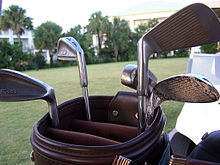By Alan Prescott
May 13, 2021
” . . . the owner of the Karsten Manufacturing Company at 2201 West Desert Cove in Phoenix, Arizona, could have bankrupted the United States Golf Association when the USGA banned one of his Ping models, the Ping Eye 2, because of the depth of the grooves and the spacing of the grooves.”

In my last article, the discussion turned to just how the PGA Golf Professionals began to lose their market share in selling pro-line golf clubs. Let’s consider the cause(s) of this change in the way in which golf clubs were sold and to whom they were sold. After years of stagnant growth of sales of pro-line golf clubs, the manufacturers began to investigate how they could increase sales and profits.
In a previous article, I briefly mentioned the Karsten Manufacturing Company, located in Phoenix, Arizona. In that discussion, I mentioned how Ping golf clubs were distributed only to PGA Golf Professionals at golf courses. I mentioned that the owners of Karsten Manufacturing Company used a unique way of finding out if a potential customer wanted to open an account to sell Ping clubs. Someone from the Karsten Manufacturing Company, after obtaining the phone number of the applicant for a new account, would call up and ask to schedule a tee time at the “supposed” golf course. When the person at the proposed new course answered, the answer was something like, “we are a retail store, not a golf course”. The Karsten representative, that tried to make a tee time, would hang up and the application for an account was likely then tossed into the trash.
The other point that I discussed in that previous article mentioned that Karsten Soleheim, the owner of the Karsten Manufacturing Company at 2201 West Desert Cove in Phoenix, Arizona, could have bankrupted the United States Golf Association when the USGA banned one of his Ping models, the Ping Eye 2, because of the depth of the grooves and the spacing of the grooves. Karsten’s assets, rumored to be about $400 million at that time, would have easily bankrupted the USGA if the legal suit had gone any further. However, it was settled out of court and the original Ping Eye 2 model with the so-called “square grooves”, were grandfathered in. The main contention was that professionals and players alike could spin the golf ball better and gain an advantage over other players, who weren’t playing those original Ping Eye 2 clubs. The settlement involved changing the clubfaces. The resultant “new” Ping Eye 2 clubs didn’t stop the golf ball as well as those that were grandfathered in. In addition to that, the original Ping Eye 2 model would shear the golf ball covers, thus yielding a shorter playing life.
There was much more to the story, and, the Karsten Manufacturing Company played a large part in the development of better golf clubs that were much easier to hit. It’s the story of how one man, Karsten Soleheim changed the playability of golf clubs for golfers of all abilities. It was brilliant and very innovative.
In my next article, I will offer a complete discussion of how Karsten single-handedly changed the game of golf by improving the playability of professional golf clubs. It’s an amazing story that I can hardly wait to tell. Stay tuned. It only gets better.
As always, I am Alan Prescott and I can be reached for comments and suggestions at [email protected]. If you want a personal response to any comments and suggestions, kindly include your email address.
Stay safe and be healthy.
A side note: This article was written in response to someone who made a comment about Ping golf clubs and implied that something was left out. In fact, there is so much to relate about the evolution of the game, marketing practices, and golf club manufacturing processes, that it cannot be related in a few words. I apologize for not being able to write everything at once. However, in my next article, I will try to cover most aspects of the above and tell the correct story, as I played a significant role in this evolution. My history in the golf business spans over 57 years and, during that entire time, I have tried to give back far more than I have received. Everyday, my career is enhanced by my strong desire to improve the game of golf as well as the “golf experience” of those people who read about it or participate in it.
Editor’s Note: Alan Prescott reached out to us after reading a recent article on the Fernandina Beach Golf Course. His articles are being well received by golfers and non-golfers. We thank Alan for his contribution to the Fernandina Observer.A
